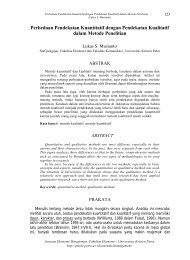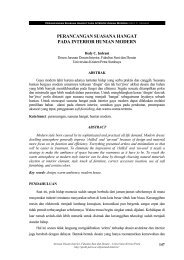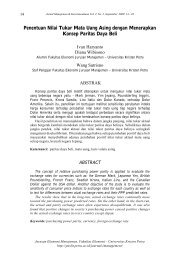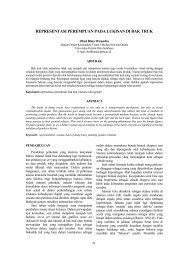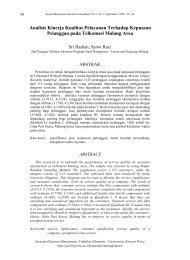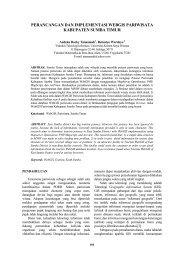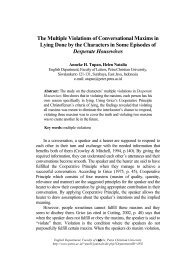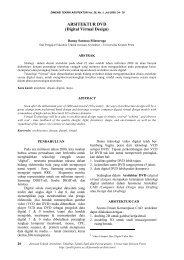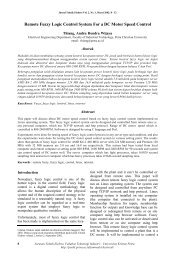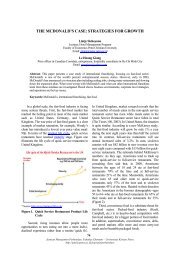A Thematic Analysis of Hawthorne's The Scarlet Letter - Puslit Petra
A Thematic Analysis of Hawthorne's The Scarlet Letter - Puslit Petra
A Thematic Analysis of Hawthorne's The Scarlet Letter - Puslit Petra
You also want an ePaper? Increase the reach of your titles
YUMPU automatically turns print PDFs into web optimized ePapers that Google loves.
A <strong><strong>The</strong>matic</strong> <strong>Analysis</strong> <strong>of</strong> <strong>Hawthorne's</strong> <strong>The</strong> <strong>Scarlet</strong><br />
<strong>Letter</strong><br />
Parvin Ghasemi<br />
Department <strong>of</strong> Foreign Languages and Linguistics, Faculty <strong>of</strong> Literature and<br />
Humanities, Shiraz University, Pardis Eram, Shiraz 71944, Iran<br />
e-mail: pghasemi2000@yahoo.com, pghasemi@rose.shirazu.ac.ir<br />
Pyeaam Abbasi<br />
Department <strong>of</strong> English, Faculty <strong>of</strong> Foreign Languages, Isfahan University,<br />
Azadi Square, Boulevard <strong>of</strong> Daneshga, Isfahan, Iran<br />
e-mail: pyeaam77@yahoo.co.uk<br />
Abstract: <strong>The</strong> <strong>Scarlet</strong> <strong>Letter</strong> is yet another story <strong>of</strong> the never-ending<br />
conflict <strong>of</strong> individuals versus society in which the recurrent theme <strong>of</strong><br />
appearance versus reality is central and woven into different elements <strong>of</strong><br />
the novel. <strong>The</strong> significance <strong>of</strong> this theme lies in the fact that it is adopted<br />
by both the Puritan Culture to subjugate its members and hide the truth,<br />
and by a protagonist who claims a new identity and violates the<br />
Puritanical codes. This is traceable in two major binary oppositions<br />
elaborated in this paper as: Society / Individual; and Religion / Love<br />
with a look at the two characters <strong>of</strong> Dimmesdale / Hester and the two<br />
colours <strong>of</strong> Sable / Gules. This paper is an attempt to show how these<br />
binary oppositions work, throughout the novel, to stress appearance as a<br />
tool for fixing Puritanical codes, and reality as a tool for constructing<br />
new ones.<br />
Key words: appearance, reality, society, Puritan Culture, individual,<br />
religion, love, sable, gules<br />
<strong>The</strong> never-ending struggle <strong>of</strong> individual versus society is a dominant<br />
theme that has appeared in many literary masterpieces. To this <strong>The</strong> <strong>Scarlet</strong><br />
<strong>Letter</strong>, the climax <strong>of</strong> <strong>Hawthorne's</strong> corpus is no exception. <strong>The</strong> conflict<br />
between social and individual values is stressed through the appearanceversus-reality<br />
theme by which Hawthorne intends to project an unresolved<br />
tension that satisfies the purpose <strong>of</strong> obscuring the truth. <strong>The</strong> individual<br />
values represented by characters like Tess, Winston Smith and Hester are<br />
symbolic <strong>of</strong> those values not in line with the public ones; characters that<br />
rebel to displace appearance represented by 'sable' are characters<br />
represented by the 'scarlet' reality.<br />
1
2<br />
VOLUME 11, NUMBER 1, JUNE 2009: 1-17<br />
<strong>The</strong> <strong>Scarlet</strong> <strong>Letter</strong>, as a tale <strong>of</strong> a war between the Puritanical Culture<br />
and a member who violates a Puritanical code, weaves the appearanceversus-reality<br />
theme into the very structure <strong>of</strong> its elements. What<br />
Hawthorne implements is the dramatization <strong>of</strong> the tension to reconsider the<br />
use <strong>of</strong> terms such as love and religion. Hawthorne creates the theme <strong>of</strong><br />
appearance-versus-reality represented by the characters to launch his attack<br />
on Puritanism. <strong>The</strong> duality <strong>of</strong> appearance versus reality is best shown when<br />
the reader finds no hope <strong>of</strong> reconciling a single character's private life with<br />
that <strong>of</strong> the public. In discussing the two kinds <strong>of</strong> man in the society, Marx<br />
(1975) as …a member <strong>of</strong> civil society is taken to be the real man" for he is<br />
in "his … sensuous, individual … existence," while "political man is …<br />
abstract, artificial man, man as … moral person" (p. 234). 1 Hawthorne tries<br />
to reveal the depth <strong>of</strong> the 'political' Puritan Culture and the significance <strong>of</strong><br />
the 'sensuous' individual who stands against the culture to create new laws,<br />
remove the appearance, and let the reality illuminate various experiences.<br />
And in dramatizing this conflict he is quite assertive although Connolly<br />
(1970) and many others believe that Hawthorne never subscribed<br />
completely to the transcendental movement and was never satisfied with<br />
what they wished to achieve at Brook Farm.<br />
<strong>The</strong> <strong>Scarlet</strong> <strong>Letter</strong> as an area <strong>of</strong> human experience shows the duality<br />
between appearance and reality differently from what may be seen in a<br />
Shakespearean work where one disguises himself or herself to test the love<br />
<strong>of</strong> another. Hawthorne talks about a culture in which the privileged group -<br />
here the magistrates - define certain religious codes for people that, in<br />
appearance, seems to be to the people's benefit while, in reality, these codes<br />
are imposed so that the people are unified and as Fox (1991) believes they<br />
are "social individuals" (p. 104) and not individuals. <strong>The</strong> Puritan Culture<br />
knows that when individuality is gone, consciousness is gone too. Thus,<br />
people change to subjects and become like the products <strong>of</strong> a society that<br />
runs everything based on appearance to bind the members together and<br />
hide the truth. For a symbolic and moralistic writer like Hawthorne, a<br />
member carrying a secret sin can best be an expression <strong>of</strong> the conflict in the<br />
mind and heart <strong>of</strong> a character that gains a new identity by violating the<br />
codes and creates her own religion and rules <strong>of</strong> nature. What follows shows<br />
how the motif <strong>of</strong> appearance–versus-reality occurs in four binary sets <strong>of</strong>:<br />
Puritan Culture / Individual; Arthur Dimmesdale / Hester Prynne; Religion/<br />
1 Refer to Karl Marx's Early Writings (1851).
Gashemi, A <strong><strong>The</strong>matic</strong> <strong>Analysis</strong> <strong>of</strong> <strong>Hawthorne's</strong><br />
Love; and Sable/Gules, the result <strong>of</strong> which is the creation <strong>of</strong> such<br />
coherence to run the final theme throughout the novel so that new lights are<br />
shed on the appearance-versus-reality technique employed by both the<br />
society to rule and keep as it is, and the individual to transform and<br />
construct anew.<br />
PURITAN CULTURE / INDIVIDUAL<br />
A jobless Hawthorne wrote <strong>The</strong> <strong>Scarlet</strong> <strong>Letter</strong> during a time which<br />
Connolly (1970) calls a "period <strong>of</strong> anguish and trial" (p. 12). <strong>The</strong> writer's<br />
anguish over the society marks the beginning <strong>of</strong> the struggle between<br />
community standards glorified by ministers, and individual values setting<br />
forth the primacy <strong>of</strong> class over individuality. In <strong>Hawthorne's</strong> New England<br />
every aspect <strong>of</strong> life is covered by laws haunting its people's imagination,<br />
putting on pious faces carrying some sort <strong>of</strong> guilt and, at home, they<br />
remove the unreal cover just to enjoy a moment's relief with real thoughts<br />
and feelings. <strong>The</strong> conflict between a free and spirited nature and a<br />
convention-based materialistic society is not new. In appearance the<br />
Puritan Culture stresses human nature common to all its members while in<br />
reality each individual is a unique self with personal desires to be fulfilled.<br />
Apparently the government injects the idea <strong>of</strong> union into the veins <strong>of</strong><br />
people so much so even a slight movement against the grain may be<br />
regarded as taboo.<br />
Stevenson (1990) in his article on Heinrich Boll's Billiards at Half Past<br />
Nine states the belief <strong>of</strong> the so-called Lambs: "<strong>The</strong>re exists a higher bond<br />
than that <strong>of</strong> simple blood kinship, a bond based on a vision <strong>of</strong> the world as<br />
a necessarily moral realm in which brotherhood is established and<br />
maintained by shared values alone" (p. 104). For the so-called Beasts who<br />
hold power over the Lambs, he says that their "guise is order and<br />
respectability, the Beast is, in fact, moral chaos" (p. 105). This is what the<br />
Puritan society employs: in order to keep people away from truth,<br />
respectability and religion are put forward as guises that protect people<br />
from losing a higher reality. Accordingly strict Puritan codes are imposed<br />
on people the outcome <strong>of</strong> which is the difficulty in distinguishing between<br />
what is right and what is wrong, between appearance and reality. Little by<br />
little people believe in the righteousness <strong>of</strong> the system and lose the power<br />
to decide for themselves.<br />
3
4<br />
VOLUME 11, NUMBER 1, JUNE 2009: 1-17<br />
Campbell (1997) in discussing 1984 states that the party's power<br />
depends on its ability to keep people ignorant <strong>of</strong> … the truth. Without<br />
knowledge, people lack the information necessary for making choices<br />
in their lives. 1984 shows the destructive consequences <strong>of</strong> individuals<br />
surrendering responsibility for their decisions, opinions, and ideas to<br />
an outside group … (p. 558).<br />
If one dares "stand out from society … [they] are <strong>of</strong>ten crushed by the<br />
system" (p. 808). This is when there exists no hope <strong>of</strong> reconciliation<br />
between the Puritan consciousness and natural instincts attributed to the<br />
self. By <strong>of</strong>fering loyalty, respectability and hereafter joy as disguises and<br />
demanding sheer obedience from the members, the Puritan Culture<br />
imposes, in reality, a hegemony which, as Williams (1976) asserts, is "a<br />
lived system <strong>of</strong> meanings and values – constitutive and constituting – …”;<br />
"taken for granted and real by people”, and "a sense <strong>of</strong> absolute … beyond<br />
which it is very difficult … to move …" and what the two symbolic figures<br />
–Hester and Dimmesdale— do is a symbolic violation <strong>of</strong> the absolute and<br />
a move beyond the apparent blessings (Webster, 1993, p. 62).<br />
<strong>The</strong>refore, the members <strong>of</strong> the society are subconsciously involved in<br />
abiding by the rules set reminding us <strong>of</strong> Althusser's "Ideological State<br />
Apparatuses" that are more effective than "Repressed State Apparatuses"<br />
(Webster, 1993, p. 59). Thus, people lose their freedom to feel, think,<br />
decide and act. <strong>The</strong> look from the authorities on individuals then becomes<br />
downward and we see them standing in a balcony above where Hester the<br />
symbol <strong>of</strong> individuality is located – the scaffold. Ipso facto the authorities<br />
by deriving individuals <strong>of</strong> the power to distinguish between appearance<br />
and reality mark themselves as sacrosanct models following whom leads to<br />
heaven, and hell awaits those who disobey. This is what the Puritan Culture<br />
knows by heart, for in <strong>The</strong> <strong>Scarlet</strong> <strong>Letter</strong>, we are faced with a crowd –"the<br />
crowd here is the whole <strong>of</strong> society" (Doren, 1966, p. 136) – coming from<br />
"an earlier time, broad shouldered, ruddy cheeked, firm <strong>of</strong> step …. <strong>The</strong>y<br />
were a stern people … repressive. <strong>The</strong>y probably put the lid on more<br />
natural human impulses and emotions than any society before or since"<br />
(Salami, 1999, p. 444). <strong>The</strong> ruling class well aware <strong>of</strong> what has been put in<br />
the heart and mind <strong>of</strong> the crowd uses ‘ideological apparatuses’ to legally<br />
constitute laws for people, and ideology represents "a way <strong>of</strong> legitimating<br />
the power <strong>of</strong> the ruling class in society" (Webster, 1993, p. 59). When the<br />
apparently supported and proved conventions are institutionalized, then
Gashemi, A <strong><strong>The</strong>matic</strong> <strong>Analysis</strong> <strong>of</strong> <strong>Hawthorne's</strong><br />
there remains no emotion or power <strong>of</strong> differentiating between the real and<br />
the apparently real. Weston (2002) believes that Puritanism "construct[s] a<br />
rigid, dualistic distinction between … emotion and society" (p. 453). <strong>The</strong><br />
outcome will be wearing happy faces and sad faces as the government<br />
dictates; those who choose a different attitude will meet punishment, which<br />
as the manifestation <strong>of</strong> the power <strong>of</strong> the ruling party, is itself a practice <strong>of</strong><br />
law. Perhaps many members highlight the point that the Bible says that the<br />
onus <strong>of</strong> judgment falls into the Lord only. However, people <strong>of</strong> that time did<br />
not meticulously investigate the Bible as long as it supported their<br />
immediate and apparent needs.<br />
Keeping such an extremely narrow view <strong>of</strong> the social standards was<br />
due to a culture coming from "a dark world where human injustice was<br />
done, but only because men fumbled in their understanding <strong>of</strong> justice …"<br />
(Doren, 1966, p. 138). Culture as the product <strong>of</strong> the existing forces is<br />
effective enough to determine people's mind set and make them unvarying.<br />
Marx's (1968) words are worth quoting here: "It is not the consciousness <strong>of</strong><br />
men that determines their being, but … their social being that determines<br />
their consciousness" (p. 181). <strong>The</strong> Puritan Culture exposes its members to<br />
the good-versus-evil criterion, shapes their consciousness, and judges them<br />
accordingly while there allows no room for judging good and evil<br />
themselves. For the people who believe to be at this level, then life<br />
becomes a blessing in disguise. Individuals are then transformed into<br />
"subjects" who are "subject to the forces <strong>of</strong> control which operate in a<br />
given society" (Webster, 1993, p. 80). When Hester objects to<br />
Dimmesdale, she says: "And what hast thou to do with all these iron men,<br />
and their opinions? <strong>The</strong>y have kept thy better part in bondage too long<br />
already!" (Harding, 1990, p. 197). "Iron men" which suggests restriction,<br />
convention and "iron doors <strong>of</strong> prison" stand in sharp contrast to the "roses"<br />
that have just sprang up before the prison suggesting birth and coming into<br />
existence <strong>of</strong> an individual possessing passion, making her own decision<br />
and letting her own "consciousness" determine her "social being."<br />
By wearing the letter A, Hester loses her individuality and ironically<br />
adopts a new real one that stands against the apparent one just to sharpen<br />
the gap between what she really is and what she seems to be. As the<br />
"roses" are set against the "iron doors," the whole forest is put in opposition<br />
to the Market Place where everyone is having their false faces on. It is in<br />
the forest – source <strong>of</strong> evil from Puritans' point <strong>of</strong> view – that people are free<br />
to be themselves. For the Puritans it implies embracing, if not the truth, the<br />
5
6<br />
VOLUME 11, NUMBER 1, JUNE 2009: 1-17<br />
reality <strong>of</strong> themselves. For the Puritans the forest is a place <strong>of</strong> evil and<br />
ironically it becomes a holy place for Hester and Dimmesdale: it is where<br />
they meet and "practice a holy feeling accompanied by beautiful and holy<br />
elements <strong>of</strong> nature" (Connolly, 1970, p. 15). <strong>The</strong> Puritan Culture is defined<br />
by the forest and the qualities it represents linking Hester with anti-<br />
Christian values. In the forest Hester shapes her true and real individuality<br />
and gives, with a Jungian glance at the setting, rise to her unconscious<br />
ready to feel differently, and like the wilderness, challenges subjugation by<br />
her words. In a way Mistress Hibbins, practicing witchcraft, becomes<br />
another revolutionary figure by joining the witches and enjoying the<br />
freedom accorded to them. And above all "witches enjoyed a rare privilege<br />
in a society that buried so many things – the privilege <strong>of</strong> telling the truth"<br />
(Salami, 1999, p. 442): for, witchcraft was regarded as an evil practice just<br />
because <strong>of</strong> its freedom in revealing the real and rejecting the apparent truth.<br />
DIMMESDALE / HESTER<br />
"I must stand up in my pulpit, and meet so many eyes turned upward<br />
to my face, as if the light <strong>of</strong> heaven were beaming from it! … and then look<br />
inward, and discern the black reality <strong>of</strong> what they idolize?" Dimmesdale<br />
continues that in "agony <strong>of</strong> heart" he has "laughed" at "the contrast between<br />
what I seem and what I am!" (Harding, 1990, p. 191).<br />
It has been reported that Hawthorne was very much in favor <strong>of</strong> a<br />
character with a secret sin hidden in the depth <strong>of</strong> the heart. Hawthorne has<br />
explored the theme <strong>of</strong> appearance versus reality in his characters, mainly<br />
Dimmesdale and Hester, as bearers <strong>of</strong> a hidden guilt that has changed their<br />
lives significantly. What Hawthorne does is the exploration <strong>of</strong><br />
Dimmesdale's character whose story is that <strong>of</strong> a "sensitive young man's<br />
initiation into sexuality with ill grace" (Salami, 1999, p. 438). Dimmesdale<br />
has, in appearance, a cloak on, which hides the reality <strong>of</strong> his sin and instead<br />
helps him wear an acceptable face. What burns him inside and in silence is<br />
taken to be the light <strong>of</strong> a celestial man standing before the mob.<br />
Dimmesdale is tortured by the guilt, for he is put in the center <strong>of</strong> the<br />
conflict between appearance – what he preaches – and reality – what he has<br />
committed. <strong>The</strong> anguish, the torture and the burden are so real to<br />
Dimmesdale that they give him "a real existence on this earth …"<br />
(Harding, 1990, p. 191). .
Gashemi, A <strong><strong>The</strong>matic</strong> <strong>Analysis</strong> <strong>of</strong> <strong>Hawthorne's</strong><br />
<strong>The</strong> reader, who is allowed to be informed <strong>of</strong> Dimmesdale's complex<br />
thoughts and feelings, finds out that as a character supported by the<br />
magistrates, the mob, and Hester, he is caught between what he has<br />
committed and what he preaches not to be committed. Hester's lover with<br />
whom lies "the responsibility <strong>of</strong> this woman's soul" (p. 66) is torn between<br />
his love for her and his duty as a permanent member <strong>of</strong> the Puritan Culture<br />
that favors reason over passion and who can ignore his passionate nature?<br />
Not only has Hester experienced his passion but also the people have<br />
enjoyed his passionate sermons which mark Dimmesdale as a figure not in<br />
line with his colleagues. Dimmesdale is considered as "a miracle <strong>of</strong><br />
holiness" and "the mouthpiece <strong>of</strong> Heaven's messages <strong>of</strong> wisdom" (p. 142).<br />
When Dimmesdale rejects the <strong>of</strong>fer <strong>of</strong> selecting a wife, it is regarded<br />
"as if priestly celibacy were one <strong>of</strong> his articles <strong>of</strong> church-discipline" (p.<br />
125). As "victims <strong>of</strong> a passion so imbued with religious sentiment … those<br />
virgins <strong>of</strong> his church grew pale around him …" (p. 142). Dimmesdale's<br />
paleness is taken as the result <strong>of</strong> "too earnest devotion to study, his<br />
scrupulous fulfillment <strong>of</strong> parochial duty, and, more than all, by the fasts and<br />
vigils <strong>of</strong> which he made a frequent practice" (p. 120). It is even concluded<br />
that if he "were really going to die, it was cause enough, that the world was<br />
not worthy to be any longer trodden by his feet" (p. 120). And all <strong>of</strong> a<br />
sudden, to the reader's surprise, the real is put in front <strong>of</strong> the appearance<br />
when Pearl identifies him with the black man: "Is it the Black man?" (p.<br />
187). Dimmesdale is a character who symbolically shows his rejection <strong>of</strong><br />
Puritanical codes and becomes the representative <strong>of</strong> individual values and<br />
actually fulfills individualization by responding to the true feeling that<br />
aroused between him and Hester. <strong>The</strong> climax <strong>of</strong> his rejection <strong>of</strong> Puritanical<br />
codes and the desire to embrace reality is when he rejects Hester's <strong>of</strong>fer <strong>of</strong><br />
escape and instead reveals his true self by approaching the scaffold at night<br />
to show another letter A red with the anger <strong>of</strong> true passion repressed and<br />
reality hidden for too long. Dimmesdale's change <strong>of</strong> mind is the hatred he<br />
shows towards Puritanism. This is obvious when Dimmesdale addresses<br />
Hester on the scaffold: "I charge thee to speak out the name <strong>of</strong> thy fellowsinner<br />
and fellow-sufferer! … believe me, Hester, though he were to step<br />
down from a high place, and stand there beside thee on thy pedestal <strong>of</strong><br />
shame, yet better were it so, than hide a guilty heart through life (p. 67).<br />
This shows Dimmesdale's eagerness to reveal the truth and the reality<br />
<strong>of</strong> his innermost powerful feelings. As a matter <strong>of</strong> fact it has been a long<br />
time Dimmesdale had wanted to stand against the Puritanical codes, stress<br />
7
8<br />
VOLUME 11, NUMBER 1, JUNE 2009: 1-17<br />
his distress towards the appearance, and defile man-made laws: "I should<br />
long ago have thrown <strong>of</strong>f these garments <strong>of</strong> mock holiness, and have<br />
shown myself to mankind as they will see me at the judgment-seat" (p.<br />
192). "Garments <strong>of</strong> mock holiness" are suggestive <strong>of</strong> the rules –religious–<br />
that have nothing to do with what is holy and right and are mocking<br />
enough to be obeyed with no light <strong>of</strong> illumination. Dimmesdale's sermons<br />
are moving and poetic to mock the reason-bound and devoid-<strong>of</strong>-sentiment<br />
language <strong>of</strong> the ministers. <strong>The</strong> irony <strong>of</strong> a fearful hypocrite man making<br />
such sermons that make people cease to fear anything but the Lord, the<br />
Omniscient, Omnipotent God shows how paying-<strong>of</strong>f the Puritan Culture<br />
has been and instrumental in blurring the boundary between apparent and<br />
real. Dimmesdale is forgiven and redeemed, for "his suffering makes him<br />
beautiful and because Hester continues to love him" (Doren, 1966, p. 133).<br />
As many authors speak through their characters, many critics have,<br />
since 1850, debated the idea that Hawthorne is after justifying a prohibited<br />
sin and introducing Hester as a cult heroine seeking fulfillment in her<br />
union; or, that Hawthorne is depicting Hester responsible for her<br />
wrongdoing.<br />
Hester, as a figure representative <strong>of</strong> fresh and striking views and nonconformities,<br />
may be a reminder <strong>of</strong> Hawthorn's interest in the American<br />
Transcendental Movement with its emphasis on the natural world and soul.<br />
Nevertheless, there is more to Hester's motives as well as potentialities <strong>of</strong><br />
her nature. When it comes to the analysis <strong>of</strong> her motives, the reader is<br />
likely to refer to her love for Dimmesdale as the real motivation. In<br />
appearance she is a fallen woman, disloyal to Puritan-defined rules while in<br />
reality, enriched by Dimmesdale's love, she changes to a cult heroine loyal<br />
to the laws <strong>of</strong> her own nature taken as her "inner life" which in Ziff's words<br />
"can be more real than … outer life" (Ziff, 1966, p. 124). And here we are<br />
presented with another outcast or renegade or whatever "trodden under all<br />
men's feet" (Harding, 1990, p. 118) who will be crushed for not being in<br />
line with the system. As a matter <strong>of</strong> fact, "the reference to William<br />
<strong>Hawthorne's</strong> infamous cruelty to the Quaker Ann Coleman anticipates the<br />
punishment <strong>of</strong> Hester …" (p. 39). <strong>The</strong> female protagonist "is judged as a<br />
guilty harlot even though she is actually a loyal loving woman" (Campbell,<br />
1997, p. 721). <strong>The</strong> differences in value and standards show the contrast<br />
between appearance and reality and "tremendous pressure against those<br />
who violate the laws <strong>of</strong> society" (p. 721). <strong>The</strong> pressure is so intense that it<br />
pushes Hester to a mental trauma and changes her to a renegade who
Gashemi, A <strong><strong>The</strong>matic</strong> <strong>Analysis</strong> <strong>of</strong> <strong>Hawthorne's</strong><br />
breaks free <strong>of</strong> the Puritan rules to become the worshipper <strong>of</strong> the temple <strong>of</strong><br />
her own nature. She cannot tolerate a society that will not allow her to<br />
reveal her true and real identity: an identity backed up with unique qualities<br />
that separate her from other passive and obedient members. <strong>The</strong> narrator is<br />
taken even by her physical beauty: "she had in her nature a rich,<br />
voluptuous, oriental characteristic, a taste for the gorgeously beautiful"<br />
(Harding, 1990, p. 83).<br />
Now for such a beautiful, wild, passionate character, Chillingworth,<br />
who seems to be a devoted physician but who is a vengeful evil man,<br />
cannot be a proper counterpart. Hester, thinking <strong>of</strong> escaping with<br />
Dimmesdale is similar to Charlotte Bronte's Jane Eyre a passionate woman<br />
dubious about going <strong>of</strong>f to France with Mr. Rochester with whom she is<br />
deeply in love. Dimmesdale and Mr. Rochester might, at the first glance,<br />
seem villains for having violated society-defined conventions. Suffering<br />
from their own particular weaknesses, the two <strong>of</strong> them seem to be Byronic<br />
heroes who are <strong>of</strong>ten "handsome, but like Lord Byron himself, who was<br />
lame, they may have a physical handicap that only increases their sex<br />
appeal" (Salami, 1999, p. 253). Moreover, both <strong>of</strong> them suffer from a sin or<br />
scandal that marks each one's past. <strong>The</strong> reader, having been given access to<br />
those levels <strong>of</strong> conscious and subconscious unknown to the world around,<br />
is likely to take side with them. All these two characters show is a saturnine<br />
front and appearance via which the reality <strong>of</strong> the experienced moment<br />
cannot be read. <strong>The</strong> Byronic hero is "an idealist" and the "sensitivity can<br />
only be revealed … when he manages to find a superior woman who can<br />
understand his true nature" (Salami, 1999, p. 253). Hester and<br />
Dimmesdale, from a Puritanical point <strong>of</strong> view, appear as rebels however,<br />
as idealists, they are after defining their own religion, consummating it as<br />
saints who stand as threats to the society.<br />
One matter <strong>of</strong> concern with regard to what Hester has done is whether<br />
she justifies it or not. Harding (1990) believes that "there is no suggestion<br />
that she believes her adulterous love is justified by its intensity or<br />
spontaneity" (p. xviii). However, she does not regret what she has done, for<br />
the best thing came out <strong>of</strong> it: Pearl, and <strong>of</strong> course "in giving her [Pearl]<br />
existence, a great law had been broken" (p. 91). Hester knows and morally<br />
accepts her sinful act and the judgment that follows showing no<br />
resentments or challenges to the power holders. In appearance Hester has<br />
reached the end for having an unforgivable sin but sin for her is a<br />
beginning; in fact, sin, with the weakening power it has, in the hands <strong>of</strong><br />
9
10<br />
VOLUME 11, NUMBER 1, JUNE 2009: 1-17<br />
Hawthorne, gives strength to Hester. It is through sin that Hester reaches<br />
experience just to enter the state <strong>of</strong> organized innocence where she can<br />
experience love and the one life running through all. And the coup-de-grass<br />
is inserted when Hawthorne shows how morally as well as emotionally<br />
Hester is developed and criticizes the religious codes defined by those who<br />
put a ban on the development <strong>of</strong> such symbolic relationships. <strong>The</strong> sin with<br />
the evil setting marks the beginning <strong>of</strong> Hester's ideal life and the revelation<br />
<strong>of</strong> her reality. <strong>The</strong> flourishing <strong>of</strong> her reality means the flourishing <strong>of</strong> her<br />
noble thoughts, deeds, and, by and all, her real personality which is hard<br />
not to sympathize with: "her breast with its badge <strong>of</strong> shame was but the<br />
s<strong>of</strong>ter pillow for the head that needed one. She was self-ordained a Sister <strong>of</strong><br />
Mercy" (p. 161).<br />
In opposing Romantic and Puritanical philosophies, Hawthorne puts<br />
the reality <strong>of</strong> the Romantic symbol and image <strong>of</strong> the revolt <strong>of</strong> imagination<br />
against the Puritanical cloaks that obscure the difference between the two.<br />
If <strong>The</strong> <strong>Scarlet</strong> <strong>Letter</strong> is regarded as a great romance, it is due to Hester<br />
whose feelings and sensations take on literary values in practicing a<br />
humanly act <strong>of</strong> love and rejecting a religion <strong>of</strong> fear for years through which<br />
she "has not consented to let her soul be killed" (Doren, 1966, p. 131). In<br />
the literal sense, Hawthorne tries to win the reader’s sympathy for Hester<br />
who is in love with the Puritan minister and not with her husband. As a<br />
person in need <strong>of</strong> loving and being loved, Hester is excused for having<br />
such an affair that likens her to 1984's Winston Smith who, through a<br />
secret love affair, fought the system. In fact, Hester finds her own judgment<br />
as the real and true consultant and dares express her freedom <strong>of</strong> choice and<br />
idea that it is the individual feeling that is the most prominent and desirable<br />
reality that exists. It is the law <strong>of</strong> her heart that she abides by and knows to<br />
be real and deep. What makes an unforgettable character <strong>of</strong> Hester is that<br />
all she is and does and feels are accompanied by her obsession with guilt.<br />
Hester has a Puritanical conscience after all and cannot avoid the<br />
compelling hold <strong>of</strong> the community and the repressive urge <strong>of</strong> her natural<br />
instinct. Hester feels the burden <strong>of</strong> the past on her shoulders "but the<br />
fortune, because its outcome is contingent on action done, is the true moral<br />
realm" (Stevenson, 1990, p. 97). Hester does not leave the place <strong>of</strong> her-<br />
guilt– Boston– and stays there to defend what she sincerely believes in.<br />
She-becomes the manifestation <strong>of</strong> the humanist view <strong>of</strong> the Renaissance<br />
period placed at the centre <strong>of</strong> the community. Accordingly she is "the<br />
individual as the source and end <strong>of</strong> ideas, action and meaning" with whom
Gashemi, A <strong><strong>The</strong>matic</strong> <strong>Analysis</strong> <strong>of</strong> <strong>Hawthorne's</strong><br />
new outlooks appear and become meaningful (Harding, 1990, p. 79). She<br />
becomes the harbinger <strong>of</strong> a new religion in which affection is the first word<br />
to be loudly preached.<br />
RELIGION / LOVE<br />
Religion has always been one <strong>of</strong> those means by which governments<br />
have defined laws and have controlled their members. Many deviations<br />
have been put to religion and different objectives have been pursued<br />
accordingly. To this, Puritanism was not an exception. Many references in<br />
<strong>The</strong> <strong>Scarlet</strong> <strong>Letter</strong> clarify that "the role <strong>of</strong> the godly in the Puritan colony<br />
had economic and social implications" (Harding, 1990, p. 14) to the extent<br />
that the narrator says "religion and law were almost identical" (p. 50). As a<br />
matter <strong>of</strong> fact, religion acts as a proper guise for what the authorities wish<br />
to either impose or obtain and shape their rules accordingly. Although<br />
religion seems to shape morality, gradually it turns to chaos; though it may<br />
display apparent harmony and benefit, in reality it may hold disorder within<br />
and not even a soupcon <strong>of</strong> affection and love. Campbell (1997) believes<br />
that "genuine emotions like … love … define people as unique individuals<br />
…" (p. 558). Godwin (1974) goes even further and puts "love to man" and<br />
"piety toward God" side by side stating that "religion is nothing, if it be not<br />
a sentiment and a feeling" (pp. 69-70).<br />
In this sense, Hester appears to be more pious by practicing her true<br />
religion when she assures her town mates that "in Heaven's own time, a<br />
new truth would be revealed, in order to establish the whole relation<br />
between man and woman on a surer ground <strong>of</strong> mutual happiness"<br />
(Harding, 1990, p. 263). Hester's religion is not defined merely by reason.<br />
Feelings are the teachings <strong>of</strong> her school for which she has fought wholeheartedly.<br />
Weston (2002) in discussing 'Puritan Temper' refers to "true<br />
religion" as "characterized by pious and benevolent feelings" (p. 451).<br />
Hester finds it indispensable to devout herself to the secret hidden in her<br />
heart if she is to be a religious, pious woman. She has to practice what she<br />
believes in and preaches. She is loyal to reality and the laws <strong>of</strong> her nature<br />
set against Puritan-made rules. It is through her love affair that Hester<br />
claims a new identity, a real one, one different from what the public is<br />
acquainted with. She, also, claims a real identity for another follower <strong>of</strong> this<br />
new school, Dimmesdale. When she cries "God gave me the child!"<br />
(Harding, 1990, p. 113), she subconsciously identifies Dimmesdale, a<br />
11
12<br />
VOLUME 11, NUMBER 1, JUNE 2009: 1-17<br />
member <strong>of</strong> the Puritan Culture, with God. Hester shows no respect for the<br />
world's law, for she knows a higher reality and truth than that practiced by<br />
the Puritans. This higher reality for Hester is love to which she remains<br />
loyal and with which she remains united. In the holy name <strong>of</strong> love she, as a<br />
cult heroine, stands up to a religion that appears merciful but is ugly and<br />
cruel to true love and affection. She stands up against a religion that has<br />
deprived her <strong>of</strong> her right to love and be loved. As a real religious and pious<br />
woman, Hester knows and believes that religion "must become a vital<br />
principle, it must affect the heart and act upon the passions, before it can<br />
greatly modify the character <strong>of</strong> man in society" (Godwin, 1974, p. 317),<br />
which means that her sin is rooted in the most perfect <strong>of</strong> all feelings: love,<br />
and the bitter irony shows how the Puritan Culture has been successful in<br />
obscuring the difference between appearance and reality and not successful<br />
in subjugating all its members.<br />
Hester believes in the healing power <strong>of</strong> love and the changes it affords<br />
men. Hester's religion is that <strong>of</strong> heart and not head, and that affection brings<br />
joy. <strong>The</strong> narrator sees Hester as an "angel and apostle <strong>of</strong> the coming<br />
revelation … l<strong>of</strong>ty … beautiful … wise" who will arrive through "ethereal<br />
medium <strong>of</strong> joy" revealing "how sacred love should make us happy, by the<br />
truest test <strong>of</strong> a life successful to such an end!" (Harding, 1990, p. 263).<br />
Bestowed with the power <strong>of</strong> love, Hester is able to change everything<br />
and show the reality <strong>of</strong> appearances. She is able to create a new identity, a<br />
real personal identity different from the apparent social one. <strong>The</strong> new<br />
identity is nourished through the feeling <strong>of</strong> love and her relationship with<br />
Dimmesdale.<br />
Hester's self is empowered through sympathy and relationship with<br />
others. She becomes strong enough to change the implications <strong>of</strong> the<br />
scarlet letter she is doomed to wear, to fresh and novel implications.<br />
SABLE / GULES<br />
At last Hester bends the 'Sable' Puritanism to show the 'Gules' reality<br />
<strong>of</strong> her self. On Hester's slab appears "On a field, Sable, the letter A, Gules"<br />
(p. 264). Brant (1958) suggests that the last line <strong>of</strong> Marvell's <strong>The</strong><br />
Unfortunate Lover may be a source for the saying: “Forced to live in<br />
Storms and Wars: / Yet dying leaves a perfume here, / And Musick within<br />
every Ear: / And he in story only rules, / In a Field Sable, a Lover Gules”<br />
(Harding, 1990, p. 293).
Gashemi, A <strong><strong>The</strong>matic</strong> <strong>Analysis</strong> <strong>of</strong> <strong>Hawthorne's</strong><br />
What is noteworthy here is the opposition <strong>of</strong> black and red that appears<br />
as a color motif throughout the work adding to its thematic unity.<br />
Hawthorne has tried to portray a black culture which is willing to disguise<br />
its members' red feelings and passion in black. <strong>The</strong> symbolic black is<br />
attributed and enriched with dualistic qualities and the black by which<br />
Puritanism is meant to be different from the dark <strong>of</strong> night and the forest.<br />
At the very beginning, the writer draws the reader's attention towards<br />
the prison and the "black rose-bush" having sprung up there and then the<br />
jailor who is "black, grim, ugly-eyed old man!" (Harding, 1990, p. 229)<br />
symbolizing the dark, macabre atmosphere <strong>of</strong> the setting. <strong>The</strong>re, then,<br />
appears Governor Bellingham the "guard <strong>of</strong> honor" with "a black velvet<br />
tunic" (p. 64) with John Wilson, the eldest clergyman <strong>of</strong> Boston, at the<br />
center <strong>of</strong> focus looking like a "darkly engraved portrait" (p. 65), and even at<br />
the Market Place the narrator notices the "general tint" <strong>of</strong> "human life" as<br />
"sad grey … or black" (p. 232). And the whole Puritanism with its<br />
ministers looks like "pine-trees, aged, black, and solemn" (p. 95).<br />
<strong>The</strong> depiction <strong>of</strong> major scenes exhibits the black Puritanical mode <strong>of</strong><br />
life and age. In such a black atmosphere and among the aged and withered<br />
spirits there appears Hester the defender <strong>of</strong> love, a critic <strong>of</strong> blind obedience,<br />
wearing the letter A embroidered in red and shining like a jewel throwing<br />
"a lurid gleam along the dark passage-way <strong>of</strong> the interior" (p. 69). What<br />
Hester does is a symbolic, sincere attempt to remove herself and<br />
Dimmesdale out <strong>of</strong> the black framework <strong>of</strong> Puritanism in order to reveal<br />
her real and red thoughts and feelings. It is in chapter 17 that the narrator<br />
refers to the emotional openness <strong>of</strong> Hester and Dimmesdale as they are<br />
standing together "with the sanguine passion <strong>of</strong> hand clasped in hand" (p.<br />
195). Hester's passionate nature is so sanguine that at the time <strong>of</strong><br />
"pestilence" or "calamity," she appears in "the household that was darkened<br />
by trouble" with the red letter glimmering "with comfort in its unearthly<br />
ray" (p. 161). Indeed numerous references to the letter A bestow unity upon<br />
the work. Any time Hester appears the letter A is there on her breast, each<br />
time suggesting an implication. <strong>The</strong> letter A is hardly recognizable for the<br />
reader to stand for a definite indisputable image or fixed signifier. <strong>The</strong><br />
sexton refers to "a great red letter in the sky" (p. 158), and the meteor<br />
makes a dome-like shape, "the letter A, --marked out in lines <strong>of</strong> dull red<br />
light,--" (p. 155) in the black sky. <strong>The</strong> appearance <strong>of</strong> comets may predict<br />
the destruction <strong>of</strong> tyrants and the termination <strong>of</strong> rulers: an end Hester and<br />
the letter A may suggest to the community. Hester, who is literally and<br />
13
14<br />
VOLUME 11, NUMBER 1, JUNE 2009: 1-17<br />
figuratively red in a black culture, is similar to the golden-embroidered<br />
letter in the middle <strong>of</strong> the rough material she has on. She was doomed to<br />
wear it, for the criminal's body had to show the sentence and in Foucault's<br />
words the sentence has to be "legible for all" (p. 43). <strong>The</strong> letter, as a<br />
signifier, signifies Hester's rebellion against 'sable' conventions and she is<br />
judged by the letter A on her heart and not by the letter <strong>of</strong> passion in her<br />
chest which makes it difficult to distinguish between the appearance and<br />
reality <strong>of</strong> the letter. Hester is seen as wearing the letter A; however, no one<br />
notices the priests wearing the letter C, suggestive <strong>of</strong>, perhaps, Cruel or S<br />
for Sanctimonious.<br />
<strong>The</strong> letter A demands an imaginative power to interpret the reality. It is<br />
not easy to take A as the initial letter <strong>of</strong> 'Adulteress.' In appearance it may be<br />
so however, other implications help to bring other suggestions to the mind.<br />
Hawthorne in Endicott and the Red Cross (1837) has written about the<br />
embroidered "fatal token" he had in mind to mean "Admirable, or anything<br />
rather than Adulteress" (Doren, 1966, p. 130). People eventually misread<br />
the letter and do not associate Adulteress for the letter A which is a<br />
signification <strong>of</strong> the fact that they also subvert the Puritan-defined system <strong>of</strong><br />
laws as if defined by God. So the letter A does not attract the world's anger<br />
but it is something "to be sorrowed over, and looked upon with awe, yet<br />
with reverence too" (Harding, 1990, p. 263).<strong>The</strong> sexton notices "a great red<br />
letter in the sky, --the letter A, -- which we interpret to stand for Angel" (p.<br />
158), and even Harding (1990) believes that the narration is in step with the<br />
"strategy <strong>of</strong> subversion," for "the narrative … undermines the stability <strong>of</strong><br />
the system <strong>of</strong> signs by which the values <strong>of</strong> the Puritan theocracy are<br />
maintained" (p. 21). Thus A can stand for Angel or Able. It may stand for<br />
Arthur – Hester's lover – or Alone – in such a society – or Against – such a<br />
culture – or Affection – Hester's religion – or Anew – building a new life<br />
and religion. Hester is Alone in the world "as to my dependence on society,<br />
and with little Pearl to be guided and protected, – alone, …" (p. 164).<br />
People conclude, "it meant Able; so strong was Hester Prynne, with a<br />
woman's strength" (p. 161). If Christianity is a religion <strong>of</strong> love, then Hester<br />
is a real Apostle spreading the teachings <strong>of</strong> Christ in that Puritanical<br />
environment. Besides, the letter with the effect <strong>of</strong> a cross gives the wearer a<br />
kind <strong>of</strong> sacredness like a "nun" (p. 163) connecting Hester and the Virgin<br />
Mary.<br />
A as the first letter <strong>of</strong> alphabet may suggest a beginning, perhaps the<br />
beginning <strong>of</strong> a new life after putting the letter on. A new life awaits Hester
Gashemi, A <strong><strong>The</strong>matic</strong> <strong>Analysis</strong> <strong>of</strong> <strong>Hawthorne's</strong><br />
after flaunting a long-held tradition <strong>of</strong> Puritan Culture. <strong>The</strong> token for many<br />
had come to mean "her [Hester's] many good deeds since" (p. 162). Hester<br />
constructs her life through helping others and keeping alive the letter A<br />
suggesting the red light <strong>of</strong> deep love in the dark sky <strong>of</strong> Puritanism. Here<br />
Hester's strength in transfiguring the signifier A is <strong>of</strong> paramount<br />
significance. Hester is able to transform the meaning from appearance and<br />
what it appears to be, to the reality <strong>of</strong> it by subverting the Puritan<br />
connotations <strong>of</strong> such symbols.<br />
What the "society would make into a stigma <strong>of</strong> shame, Hester converts<br />
into a thing <strong>of</strong> beauty, just as she converts the living symbol <strong>of</strong> the letter A,<br />
Pearl, into a thing <strong>of</strong> beauty by her elegant dress" (Connolly, 1970, p. 14).<br />
By refusing to let her scarlet letter be removed, she symbolically remains<br />
loyal to her lover – Arthur – and her real identity as Able and Angel and<br />
becomes "a living sermon Against [emphasis mine] sin" (Harding, 1990, p.<br />
63) <strong>of</strong> hiding the truth and making people put on false faces and be good<br />
and loyal members in appearance.<br />
As a writer interested in the secret sins people may carry in their hearts,<br />
Hawthorne explores the implications <strong>of</strong> a secret act <strong>of</strong> a soul in New<br />
England, Boston. Hawthorne presents the reader with the Puritan Culture<br />
with all the apparatuses the system employs in order to subjugate its<br />
members and hide the truth.<br />
<strong>Hawthorne's</strong> social, moral, and religious milieu provided him with raw<br />
materials which went into this superb literary piece that is the story <strong>of</strong> two<br />
characters living with the weight <strong>of</strong> what they have done and what follows.<br />
<strong>The</strong> novel puts forward the everlasting conflict between the society and the<br />
individual. What is novel and eye-catching is the recurrent theme <strong>of</strong><br />
appearance versus reality woven into different elements <strong>of</strong> the novel all<br />
throughout. Man's individuality has always been threatened and in some<br />
cases stifled by convention which is disguised in varied forms such as<br />
religion, family, society-defined rules, and particular social, political,<br />
economical codes. Rejection <strong>of</strong> each can be taken as the assertion <strong>of</strong> a new<br />
reality and identity, the eruption <strong>of</strong> which threatens the foundations <strong>of</strong><br />
priesthood or whatever is hidden under the cloak and appearance <strong>of</strong><br />
morality.<br />
As a matter <strong>of</strong> fact, it is the very theme <strong>of</strong> appearance versus reality by<br />
which Hawthorne presents a symbolic figure with a symbolic violation <strong>of</strong><br />
the society-defined rules and the unexpected consequences. That is what<br />
makes readers lack consensus about the final meaning and interpretation <strong>of</strong><br />
the characters and events.<br />
15
16<br />
CONCLUSION<br />
VOLUME 11, NUMBER 1, JUNE 2009: 1-17<br />
<strong>The</strong> <strong>Scarlet</strong> <strong>Letter</strong> is not only about good and evil but appearance and<br />
reality, a theme practiced all throughout the novel. As it is stated at the end<br />
<strong>of</strong> the novel, "no man, for any considerable period, can wear one face to<br />
himself, and another to the multitude, without finally getting bewildered as<br />
to which may be the true" (p. 216). Dimmesdale and Hester are judged<br />
based on appearance, and a gradual revelation <strong>of</strong> their reality marks them<br />
as adversaries to those who want to blur the difference between appearance<br />
and reality. <strong>The</strong> narrator, in the concluding chapter, cries "Be true! Be true!<br />
Show freely to the world, if not your worst, yet some trait whereby the<br />
worst may be inferred!" (p. 260) to show how the Puritan Culture provides<br />
the characters with a setting where "the secret acts <strong>of</strong> the soul are matters <strong>of</strong><br />
public concern, in which the [symbolic act <strong>of</strong>] adultery is a crime against<br />
the state," (Ziff, 1966, p. 126) and ironically the letter A must be worn to<br />
make the secret public, and therefore to intensify the confusion. However,<br />
Hester's religion is one <strong>of</strong> love and affection and with the power she is<br />
bestowed, she subverts Puritanical significations to create new ones and<br />
therefore takes refuge in her heart to gain more power from the scarlet letter<br />
and reject the 'sable' culture. Hawthorne shows the reality <strong>of</strong> the token,<br />
what in appearance is a "scorching stigma" (Harding, 1990, p. 247) while<br />
in reality and by Hester has changed to a badge <strong>of</strong> courage, affection and<br />
ability.<br />
Hester's lover also has the brand <strong>of</strong> sin on his heart and as a violator <strong>of</strong><br />
the Puritanical codes makes the reality known to all that we are all sinners,<br />
yet some are disguised in cloaks as law makers and gods. Hester reveals<br />
the fact that under every 'Gules' letter, there lie much deeper meanings than<br />
what the 'Sable' culture tries to uphold.<br />
REFERENCES<br />
Campbell, W. J. (1997). <strong>The</strong> book <strong>of</strong> great books: A guide to 100 world classics.<br />
New York: Wonderland Press.<br />
Connolly, T. E. (1970). <strong>The</strong> scarlet letter and other tales. New York: Penguin<br />
Books.<br />
Doren, M. V. (1966). <strong>The</strong> scarlet letter. In A. N. Kaul (Ed.), Hawthorne: A<br />
collection <strong>of</strong> critical essays (pp. 129-141). New York: Prentice-Hall.
Gashemi, A <strong><strong>The</strong>matic</strong> <strong>Analysis</strong> <strong>of</strong> <strong>Hawthorne's</strong><br />
Fox, R. (1991). <strong>The</strong> novel and the people. London: Commonwealth Publishers.<br />
Godwin, W. (1974). Life <strong>of</strong> Chaucer (2 nd ed.). New York: AMS Press.<br />
Harding, B. (1990). <strong>The</strong> scarlet letter. Oxford: Oxford University Press.<br />
Marx, K. (1968). Preface to A contribution to the critique <strong>of</strong> political economy.<br />
London: Lawrence and Wishart.<br />
------------. (1975). Early writings. (R. Livingstone, Trans.). Harmondsworth: Penguin<br />
Books. (Original work published 1851).<br />
Salami, I. (Ed.). (1999). Study <strong>of</strong> thirty great novels. Tehran: Mehrandish Books.<br />
Stevenson, D. (1990). <strong>The</strong> temporal-moral matrix <strong>of</strong> Heinrich Boll's billiards at<br />
half-past nine. 20 th Century Literature, 36(1), 95-113.<br />
Webster, R. (1993). Studying literary theory. London: Hodder Headline Group.<br />
Weston, R. (2002). Politics, passion and the 'Puritan temper': Godwin's critique <strong>of</strong><br />
Enlightened Modernity. Studies in Romanticism, 41(3), 448-469.<br />
Williams, R. (1976). Keywords. London: Fontana.<br />
Ziff, L. (1966). <strong>The</strong> ethical dimension <strong>of</strong> "<strong>The</strong> Custom House." In A. N. Kaul<br />
(Ed.), Hawthorne: A collection <strong>of</strong> critical essays (pp. 123-129). New York:<br />
Prentice-Hall.<br />
17





